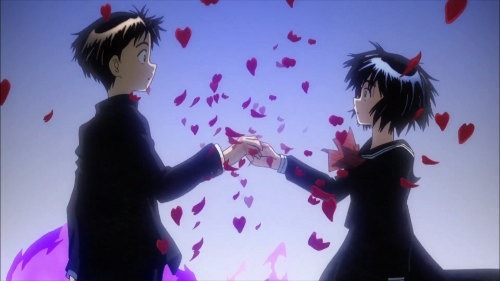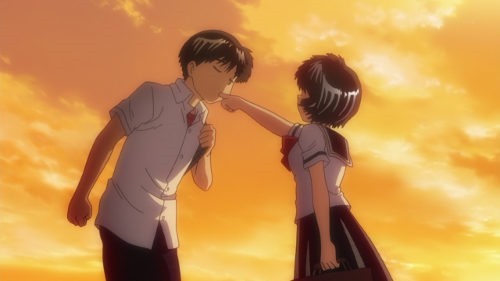Last time, I covered the bigger picture surrounding Katawa Shoujo, namely visual novels and eroge, and touched on the themes and impressions I got. This time, I plan to take a closer look at the plot and characters. I’ll also be peppering this profusely with nitpicks and gripes.
I should warn you, while I will be refraining from divulging any true spoilers, I will be assuming you’re not worried about me mentioning details that either occur very early in the game or won’t be surprises at all if you’re following along. If this were a review of The Sixth Sense, I would mention him getting shot (happens near the beginning) but not the bit about him being dead.
 As a product of volunteers, the overall quality of Katawa Shoujo is impressive. There are some wonderful CGs to behold and the artwork is always pleasing. The music, too, is usually pretty good, and there are enough tracks that it hardly ever seems too repetitive, unless of course you play for hours and hours on end. Sound effects are always perfectly adequate but admittedly they aren’t used too terribly much.
As a product of volunteers, the overall quality of Katawa Shoujo is impressive. There are some wonderful CGs to behold and the artwork is always pleasing. The music, too, is usually pretty good, and there are enough tracks that it hardly ever seems too repetitive, unless of course you play for hours and hours on end. Sound effects are always perfectly adequate but admittedly they aren’t used too terribly much.
While characters have many varied poses, expressions, and even a few outfits usually, the stories are long enough that you really start to wish there were a few more. Maybe it is also because the CGs, while always good, are few and far between. Sure, there are usually a dozen or more for each story, but when each story has easily 4-6 hours of text, you’ll feel like the CGs are spread thin.
The fact that it was a group effort does show, though the coordination is great. The team seems to have been careful to keep consistency of outfit designs, locales, and other details, despite having so many different artists contribute. And honestly, it was kinda neat to see so many different takes on the same characters. Each artist kept it within the feel of the game, but still undeniably their personal style. This is a totally different effect when coming from commercial ventures, which, while still employing a team of artists, almost universally slavishly adhere to a single style. I’m not saying one is better than the other, though, just different approaches, although Katawa Shoujo’s might be more out of necessity.
Honestly, though, the biggest problems aren’t with the artwork, but with the consistency of writing. My guess is that a different writer mostly wrote and handled a single girl’s story. There seems to be plenty of editing, and I don’t think I saw but maybe one or two possible goofs in the text. The different places and events and other things also overlap well, giving the world a persistent feeling even when exploring a new girl’s path, which is effectively an alternate timeline of sorts. It’s especially rewarding when you get to see several sides of an event or backstory (Shizune and Lilly especially).
Where the cracks show is comparing the various girls’ stories. There is a noticeable shift in writing style and, I’m afraid, quality, among them. Depending on which girl’s path you end up on first might have a big effect on your enjoyment. Which is a shame for the all important first impression, as it might mean the difference between you continuing to play or never feeling like it. It’s too bad, because some of the stories are quite good. None of them are outright bad, though… just noticeably inferior. It was frustrating going from a good one to a so-so one.
I’ll tackle each girl’s story next, and again I warn you that I may reveal some details here and there, but I promise it is never any surprises or really important bits. Still, you may want to stop here until you’ve played it yourself. You’ll also likely find it more interesting reading each one after playing that girl’s story yourself.
Now, in the order that I played them.
Emi
I admit, I’m a sucker for the cute ones. Emi reminds me a lot of an older Sakura from Card Captor Sakura. I was a sucker for Sakura and I’m a sucker for Emi. As soon as she bumps into you in the introductory part I was all about them twin-tails.
It helps that Emi is adorable, sometimes too much so. While she is a genki type (fitting of her appearance) she is usually very straight-forward and easy-go-lucky, instead of being airheaded or annoying, though she can be a bit plucky. Her cheerful demeanor is nicely contrasted with the hints dropped early on of her not having many close friends besides Rin. Her attitude of “no shame in having no legs” is refreshingly strong and confident, eschewing the typical female-is-weak trait. It also fits in logically with the later themes of her story about mortality and transience.
Emi’s story is one of the stronger ones, technically and structurally. Personalities, events, and dialog all fit together well and imply a good deal of thought was put into the planning and pre-writing. (I was a creative writing minor in college, so I was at least trained to notice these things.) There are also a good handful of interactive choices to be made, and you can end up on an alternate “bad” path, though there is even a very plausible way to reverse the course and get back on the “good” path without resorting to unnatural story tricks. None of the other stories, to my knowledge, manage to pull this off.
Emi lost her legs in an accident and must use prosthetics (she switches between blade-like running ones and more “natural” looking ones when trying to be casual). Her passion is running and as Hisao you are initially stuck running in the mornings with her by request of the nurse to strengthen your heart. It’s a little contrived, but not terribly, and the characters all help sell it well enough. It also provides a convenient plot device to get you and her together consistently and, more importantly perhaps, alone, since you run early in the morning when no one else is around.
Rin, another girl you can pursue, is Emi’s closest friend and lives in the dorm room across from her. I’ll have more to say about her in her section, but suffice to say she’s an enjoyable extra during Emi’s story, providing both frequent humor due to her general weirdness and also some occasionally lucid conversations. She thankfully never feels much like a third-wheel, another point in favor of the writer.
Overall, I quite enjoyed the consistency of the characters and the well presented themes. I’ve already covered the anal scene in my last post, so you have a taste of what I mean. This was the most “real” story, at least as could be expected from the genre and the premise of a school for disabled kids. It’s a good “first” story to get you really into the game. I thought maybe I was just lucky, but apparently Emi is frequently folks’ first so far as I’ve been able to see on the KS subreddit.
Shizune
My first time playing I was getting quite close to ending up on Shizune’s path, until I got side-tracked by Emi when she bumped into me, of course. Continuing, I decided to follow through with her since it would require the least amount of shifting my decisions during the introduction, which I had more-or-less chosen as I felt I would have really done.
Shizune is deaf and as such is followed around by her “better half” Misha who translates with sign language what everyone else is saying and also recites back to others what Shizune says. I was immediately intrigued because it felt like an interesting dynamic, and I was curious how they would pull off a heart-warming story where one of the primary leads cannot talk. Deafness is also one of those conditions with no outward qualities (unlike, say, Emi, who is missing legs), thus feeling less “alien” to the typical player. The motif of silence also has a lot of potential for both strong related themes and scenes.
Unfortunately, deafness is also a difficult problem from a technical writing standpoint. Having a primary character unable to contribute dialog except through a third character puts a lot of pressure on the writer, especially when as the other lead and player you cannot talk directly to her either. It also means it’s impossible to have very meaningful scenes with the two characters alone, as they cannot converse at all without Misha around. Not very romantic.
This issue seems to have driven a lot of the choices in the plot, but disappointingly to no exciting ends. In an effort to solve some of the big problems I just mentioned, our hero very quickly decides to learn sign language. Magically, he’s apparently able to pick up a lot in mere days. By like a week in he’s practically fluent enough to have full conversations. While I sympathize a bit with the author’s predicament, it still ends up being far too convenient and unbelievable.
It also doesn’t help that the plot meanders around, trying to figure out what it wants to do. It drags in lots of places, primarily due to having very few truly interesting scenes and too many slice-of-life slow character building. It’s not that they are bad, but things could have been significantly tightened up and more effectively delivered with some better planning. (And what the heck is with her family?!)
Misha also suffers from being under-developed. If she were more like a typical side-character it wouldn’t be so noticeable, but her translation necessitates her being in almost every scene. Suddenly she’s damn close to a primary character except not the focus. It felt like she got a ton of screen time (not a bad thing) but yet hardly much meaningful development. It’s especially frustrating, too, due to a very late reveal that comes out of nowhere but could have been foreshadowed better and woven in from the beginning for a much more interesting character. By the time this reveal comes we still don’t know all that much about her or why she is even at the school (she doesn’t seem to have any disability like the other students, though fans love to speculate). She mentions wanting to become a sign language teacher but she also mentions not knowing sign language at all until arriving and subsequently getting sat next to Shizune so… why did she originally come? (And don’t get me started on the sweatshirt she wears… you’ll know it when you see it.)
There is also an arbitrary rivalry between Shizune and Lilly, another of the girls you can pursue. Despite several scenes with the two and several more where Shizune is questioned on it, I still felt like I never got a good reason for it all. Especially distressing since Shizune’s so often very logical and purpose-driven, and an arbitrary hatred feels very out of place. It had the opposite effect of making me feel bad for Lilly and liking Shizune less. I would not find out some very important details about it until playing Lilly’s path, though they were nothing that couldn’t have also been revealed in Shizune’s story.
Shizune is also very difficult to figure out. She’s serious, highly competitive, and all about dedication and hard-work, but yet constantly is shown skipping classes, taking breaks, and goofing off with Misha and the player. So which is it? She can be a fascinating case study at times, with her never dwelling on the past, good or bad, and always approaching each task independently and with equal zeal.
But it’s just not a very heart-warming tale. There’s not enough intimacy, the single point of drama is too sudden, and the ending is too… er… friendly? Ultimately, I enjoyed it, I don’t mean to sound so harsh, but nevertheless it feels like the odd one out of the bunch, what with most of the stories being so heavy on the romance/drama. (But WTF is up with the one measly decision point? So much for being interactive…)
Hanako
I tried to avoid spoilers or much else before I played, choosing (as I usually do with things) to be as virgin as possible, my appetite whetted just enough to get me to download and install the game. Hanako’s name had already come up a lot, so her reputation preceded her just a bit.
I could tell immediately on my first play-through that a lot of Hanako’s appeal is due to her incredibly manipulative design, both character and story. Let’s take a look at what we know/notice about her, even in the first classroom scene of Act 1. She’s scarred, she’s impossibly skittish, and adorably meek/shy. The event, whatever it must have been, has left its mark on her body as well as her personality. A house fire perhaps? Likely killed her parents, too? I’m not spoiling anything, as she’ll tell you this outright as soon as you start on her path, and it’s not like it takes a rocket scientist to guess it either. Her timidity prevents her from making any close friends (besides for Lilly, which is actually quite clever: Lilly is blind to Hanako’s scars, in both ways). Combine this with her possibly orphaned background and, well…
All of this exploits, to an amazingly effective degree, the typical audience for this game: young sensitive male. White Knight syndrome, indeed. Coddle her, hug her, tell her it’ll be okay, make her feel loved, and extract one of those small, but oh-so-meaningful smiles. You’re not interested yet? Even my girlfriend, who gave this game a shot out of curiosity, was immediately drawn to Hanako, only reinforcing to me that Hanako’s appeal is universal.
And I was 100% correct.
Hanako’s story has zero surprises, but you won’t really care because you’ll be too caught up in it. The scenes that unfold seem to have no shame in pulling every heartstring they can, exploiting every weakness in you they can. And you’ll be a sucker for it every time. No amount of rationalizing it, as I am now, will change the fact that it works. Maybe too well. You win, Hanako.
Not that her story doesn’t still have some issues. There were times I felt the scenes were a bit rushed and other times too slow. You’ll also hardly learn a lot about her, what with her timid nature producing but a slooow trickle of personal details. I also think the writing could have benefited from being a bit bolder at times, instead of so cliché and predictable. Then again, the tried-and-true is just that, after all. It works, but I still felt just a little bit unsatisfied once the credits started rolling. I suppose it is a testament to the potential, had they had real funding behind this it could have been truly great.
As a final note about her story, I did appreciate how much more the supporting cast was utilized this time. Lilly makes for a good side-character for Hanako, and we even learn a bit about Lilly’s personality and family. So often in these stories it starts to feel like many of the characters introduced in Act 1 just kind of disappear once Act 2 begins. I know they have to focus on the main girl for that story but it can start to feel myopic at times. It wasn’t so bad this time around, though.
Rin
Rin is weird.
The internet loves her weirdness, but the internet is generally weird too. In Emi’s story, Rin provided a lot of nice comic relief and all, but… to pursue as a girlfriend? Could I get into her? I dunno…
Rin is subtle. I never really felt mushy over her (like Emi or Hanako) but, even so, the later parts of her story were surprisingly dramatic. I guess her strange behavior made me think they couldn’t possibly pull off a serious heart-wrenching tale. Like so much about her, it was more nuanced than that. Rin doesn’t overtly exploit you like Hanako, nor does she rely on Emi’s contrast of external vs. internal.
Rin is honest. She’s always herself, weird as that may be, but she wears no mask. She’s hard to figure out, but that’s because her story explores themes of identity, understanding yourself and others, and how others understand you. It’s about the limitations of our ability to understand ourselves and others. And not letting that hold you back. Really, it’s very good stuff. Important, too. And it was, more or less, pulled off well.
I was also curious how they would pull off the sex scenes with Rin, given that she is both weird (and kinda asexual almost?) but also missing arms. But they did it with skill and care, as always. It also managed to really shock me the first time, but not because of any gratuitous display or anything (they were tasteful as always). No, it’s more due to something right in plain sight: she has no arms and no hands. She cannot pleasure herself.
Imagine, for a moment, the frustration of never being able to properly channel lust and desire. You’re a cripple, so most guy’s are too intimidated by your obvious lack of arms and, worse, your alien ways of using your feet for everything. Imagine going through puberty and nearing 20 years old and not ever being able to embrace or satisfy that budding sexuality within you. Suddenly, her asexual vibe makes perfect sense, as she must surely suppress that side of her. Imagine what that does to one’s psyche and development with intimacy.
And so it was even more impactful when, throwing away inhibitions, she could be intimate with you, the player. She’s quite a different person. But it still fits with the theme of identity and “being okay with being yourself”. Sex is complicated and intimidating, such a naked act (figuratively and literally), where a lot of your very real desires are made embarrassingly clear to another human being. A lot of the joy of sex comes with being comfortable, able to focus on the moment and pleasures, rather than agonizing over fear or rejection.
Lilly
Elegant, kind, sweet, but boring. That was my first impression, at least. I appreciated her side-character status in Shizune and Hanako’s stories, especially where you get to see bits and pieces of her manipulative-but-means-well motherly side. How would she fare in the spotlight, though?
Lilly benefits well from being cute, less in that moe-way like Emi and more refined/demure/classically cute. It doesn’t hurt either that she’s easily the sexiest (it’s the neck, I’m such a sucker for the neck), which might explain her larger share of sex scenes. But the positives start running dry there, and have you noticed they are all a bit shallow?
Lilly’s story is pleasant but largely lacking in enough drama, aside from the occasional heart flutter (which rears its ugly head in other stories, too). The love that emerges almost seems to happen spontaneously, out of nowhere, and not even in a “love at first sight” way (no pun intended). Rather, they just sort of suddenly decide they love each other, madly even, in that lovey-dovey cutsey-wootsy way. It seems a bit out of character, too, for both of them.
And let’s talk about that surprising sex-drive of hers. I don’t for a minute think it is impossible for her to be a sex-kitten underneath. I’m practically a feminist, despite my penis. But if you’re going to make your female character a bit of a nymph, at least hint at it before hand? I won’t say she’s a “slut”, but it was a bit jarring given her proper and detached air leading up. Sure, you get hints that she can be a bit girlish and playful but that’s quite different.
Things happen quite quickly but it’s not all bad, just a bit cliché. Really, that’s her in a nutshell. There is still plenty of good stuff, though, especially due to the heavy use of secondary characters. You’ll learn a lot about her sister Akira, Hanako has a mini-arc of sorts that fits with her own story in a lot of ways, and there’s even some more interesting backstory involving Shizune and Lilly. But, again, this means I appreciated it more for it filling me in on the other side-characters than for Lilly in particular. In the end, she still works better as a side-character herself, I think.
Kenji
Though not one of the story girls, he is perhaps the most prominent secondary character (and, also, you can technically get the bad ending to the introduction if you fail to go down any of the girls’ story paths, and this counts as the “Kenji ending”).
Kenji is… well. How to put it. He’s too obviously comic relief. His obvious Harry Potter look and wild, random rants feel extremely out of place most of the time, interrupting the flow of the main story with all of the grace of a rhino. Worse, his scenes rarely have any significance outside of breaking up the serious stuff with his hijinks. Even then they feel too obviously trying.
I won’t lie, I chuckled many times (especially the scene where he takes his glasses off in Shizune’s story), but I still felt on the whole he was a glaring blemish on an otherwise carefully prepared surface. His tone, diction, and subject matter too often clashed with everything else, involving weirdness, obvious internet culture references, profanity, and so on, things that the game otherwise seemed keen to avoid in order to present itself as a more serious work (which I think is the right choice). He never failed to remind me that I was playing a game written by internet goons. That’s not good when you’re building atmosphere and a narrative world.
If they had just toned him down, or somehow written him more naturally into the scenes, maybe… oh well. I didn’t hate him, though. He was a lot of fun, but he did break the spell too often.
Final thoughts
This game, being a VN written specifically for and to an English audience, has managed to convert a lot of folks. Many report KS as being their first experience playing a VN. I’m not sure how I feel about that, but I think it is probably good on the whole.
More importantly, though, it is a serious attempt at dramatic fiction, and its odd premise and anime/internet roots help it attract an audience that may not be used to opening themselves up to “feels”. Reading through the weekly posts on the KS subreddit of guys who have been emotionally crushed by Emi’s story, brought to tears by Hanako's good ending, and so on, leaves me feeling conflicted. I so want to scoff and say “what a buncha fools” but… even so, I can’t help but sympathize with them. I know kinda where they are coming from, and I can imagine how someone not used to getting attached to a character and a narrative could be left such a wreck afterwards.
And yet, so many have been inspired, too. Inspired to run and get in shape (do it for her!), inspired to learn to like themselves better, to be more assertive with their life, or even just to better appreciate their own lives/girlfriends. Find friends, find love, but above all do. That’s really beautiful, more so than any of the words in the game.
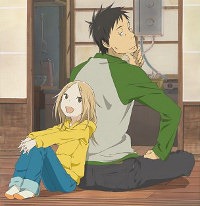 Family, as far as relationships go, is in that strange limbo between loving and obligated. Most of your family you don’t get to choose (unfortunately), and despite differences there’s that ever present “bond” we see manifest at times. They fight and quarrel and love and take care. Well, usually.
Family, as far as relationships go, is in that strange limbo between loving and obligated. Most of your family you don’t get to choose (unfortunately), and despite differences there’s that ever present “bond” we see manifest at times. They fight and quarrel and love and take care. Well, usually.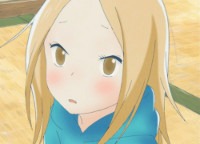 Watching the two of them is by far the highlight of the series. Rin is cute, a little precocious, but still very much a kid. However, she’s never an annoying kid, which is a difficult line to walk successfully. Daikichi himself is a bit aloof and clumsy but means so well. As he reaches out to other coworkers and parents, trying to figure this all out, to be a proper guardian, you can’t help but to think about things too. About family, what it means to be a parent, and the sacrifices parents must make. What about single parents, like Daikichi? What about folks in a rocky marriage?
Watching the two of them is by far the highlight of the series. Rin is cute, a little precocious, but still very much a kid. However, she’s never an annoying kid, which is a difficult line to walk successfully. Daikichi himself is a bit aloof and clumsy but means so well. As he reaches out to other coworkers and parents, trying to figure this all out, to be a proper guardian, you can’t help but to think about things too. About family, what it means to be a parent, and the sacrifices parents must make. What about single parents, like Daikichi? What about folks in a rocky marriage?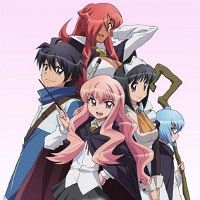 Fantasy is a genre that rarely sees much innovation. It is the great irony that this area of fiction known for far-reaching adventures and fantastical imagination involving new races, creatures, magic, and cultures, could be so shackled by its own standard conventions. Combine that with the shackles of your standard tsundere-led slapstick harem anime and it’s nearly destined to be both frustrating and popular (which is also frustrating).
Fantasy is a genre that rarely sees much innovation. It is the great irony that this area of fiction known for far-reaching adventures and fantastical imagination involving new races, creatures, magic, and cultures, could be so shackled by its own standard conventions. Combine that with the shackles of your standard tsundere-led slapstick harem anime and it’s nearly destined to be both frustrating and popular (which is also frustrating).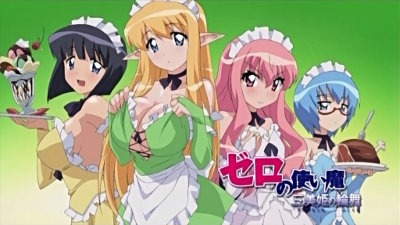
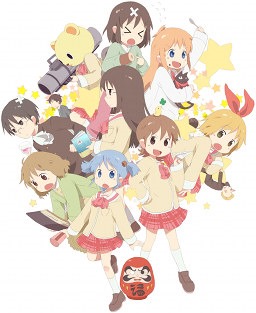 Let’s get this out first thing:
Let’s get this out first thing:  And that’s about it for story. Like I said, very little plot, basically just enough to connect characters and some vague passage of time. There are some slowly developed things, like Mio’s manga artist aspirations, Nano’s desires to be normal and fit in, or Misato’s crush on the weirdly formal and over-the-top Sasahara. Mainly, though, the series thrives in short vignettes, sometimes lasting mere seconds, others that last a third of an episode. Most are on the order of a few minutes and are separated by scene titles (again, just like AzuDai– sorry, can’t stop comparing!) and all which run the gamut of weird. Sometimes it’s simple gags, sometimes it’s nonsensical and pointless, and sometimes it’s heavily played up action. You really never know, but after awhile you get a feel for the kind of things they like to do. If after two or three episodes you don’t like it, don’t expect it to change. It’ll still continue to surprise you with weirdness but the style and delivery will be quite well known by then.
And that’s about it for story. Like I said, very little plot, basically just enough to connect characters and some vague passage of time. There are some slowly developed things, like Mio’s manga artist aspirations, Nano’s desires to be normal and fit in, or Misato’s crush on the weirdly formal and over-the-top Sasahara. Mainly, though, the series thrives in short vignettes, sometimes lasting mere seconds, others that last a third of an episode. Most are on the order of a few minutes and are separated by scene titles (again, just like AzuDai– sorry, can’t stop comparing!) and all which run the gamut of weird. Sometimes it’s simple gags, sometimes it’s nonsensical and pointless, and sometimes it’s heavily played up action. You really never know, but after awhile you get a feel for the kind of things they like to do. If after two or three episodes you don’t like it, don’t expect it to change. It’ll still continue to surprise you with weirdness but the style and delivery will be quite well known by then.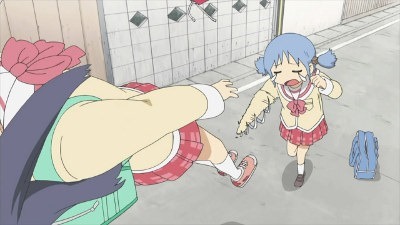

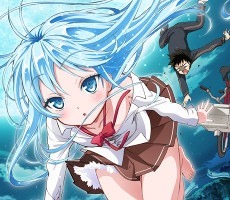 If I could describe this series in one word it would be frustrating. On it's surface you'll be roped in, as I was, by the high production quality of the art, which is mostly a traditional anime style with an extra dose of daintiness over some stunningly gorgeous backgrounds. But then the nonsensical title will throw you way off (it translates, poorly, to Electric Wave Woman and Youthful Man). And so begins a long chain of clashing vibes.
If I could describe this series in one word it would be frustrating. On it's surface you'll be roped in, as I was, by the high production quality of the art, which is mostly a traditional anime style with an extra dose of daintiness over some stunningly gorgeous backgrounds. But then the nonsensical title will throw you way off (it translates, poorly, to Electric Wave Woman and Youthful Man). And so begins a long chain of clashing vibes.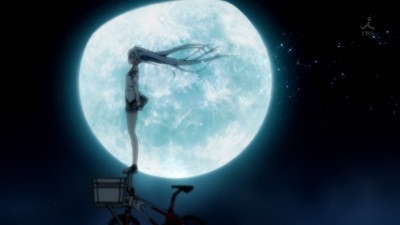
 The other elephant in the room I've so far mostly skirted around is the obvious one: the girls in this show are cute. Really cute, in that way that only Dengenki stuff can be. Scenes often flirt with the viewer, coming very close to fan-service at times, and always seem to be toying with you. A conspicuous haze of sexual tension permeates most scenes, too, sometimes a bit unnervingly so (again, Japan's obsession with incest). As a guy, I can't say I didn't enjoy the visual teasing. Alluring shots of skin, close-ups of glossy lips, and the general harem-ness of the whole thing, all contribute to the charm of the show. Make sure you are prepared for a lot of adorableness. The whole "adolescent points" system seems to further this theme of sexual maturity and latent pubescence, even explicitly calling attention to it for the purposes of assigning a point value at the end of each episode. An interesting, though admittedly gimmicky, touch.
The other elephant in the room I've so far mostly skirted around is the obvious one: the girls in this show are cute. Really cute, in that way that only Dengenki stuff can be. Scenes often flirt with the viewer, coming very close to fan-service at times, and always seem to be toying with you. A conspicuous haze of sexual tension permeates most scenes, too, sometimes a bit unnervingly so (again, Japan's obsession with incest). As a guy, I can't say I didn't enjoy the visual teasing. Alluring shots of skin, close-ups of glossy lips, and the general harem-ness of the whole thing, all contribute to the charm of the show. Make sure you are prepared for a lot of adorableness. The whole "adolescent points" system seems to further this theme of sexual maturity and latent pubescence, even explicitly calling attention to it for the purposes of assigning a point value at the end of each episode. An interesting, though admittedly gimmicky, touch.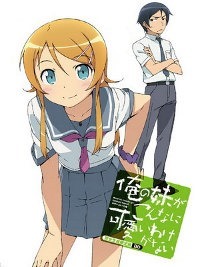 As far as pitches go, "guy finds out his younger sister is secretly an erogeotaku" is certainly one that piqued my initial interest. It's obvious wish-fulfillment to the target audience, but the show plays around with homages and parodies to other well-known anime franchises and styles frequently enough that the blatant pandering is actually part of its appeal. It thankfully always keeps winking at the viewer, as if to say it knows very well what it's doing, thank you.
As far as pitches go, "guy finds out his younger sister is secretly an erogeotaku" is certainly one that piqued my initial interest. It's obvious wish-fulfillment to the target audience, but the show plays around with homages and parodies to other well-known anime franchises and styles frequently enough that the blatant pandering is actually part of its appeal. It thankfully always keeps winking at the viewer, as if to say it knows very well what it's doing, thank you.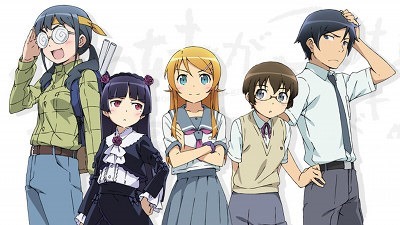
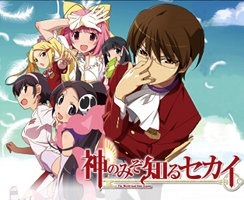 As a medium, anime sits nestled between two potentially very powerful qualities. As half art, in the traditional sense, it can choose to venture into the highly symbolic, expressive, and deeply meaningful. As half cartoon, it can exploit visual short-hands and exaggerations to great economy. Anime, as a class of media, has many sub-genres, but even taken as a whole most animes tend to follow a lot of the same "rules" (tropes, really). When used correctly, one can get a lot of enjoyment as they set us up for expectations and either meet them or not.
As a medium, anime sits nestled between two potentially very powerful qualities. As half art, in the traditional sense, it can choose to venture into the highly symbolic, expressive, and deeply meaningful. As half cartoon, it can exploit visual short-hands and exaggerations to great economy. Anime, as a class of media, has many sub-genres, but even taken as a whole most animes tend to follow a lot of the same "rules" (tropes, really). When used correctly, one can get a lot of enjoyment as they set us up for expectations and either meet them or not. Got a friend who’s not into anime but you kinda wanna show them something to change that? Well, you could always show them School Days and then you wouldn’t have a friend anymore to worry about.
Got a friend who’s not into anime but you kinda wanna show them something to change that? Well, you could always show them School Days and then you wouldn’t have a friend anymore to worry about.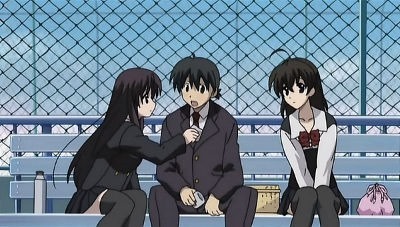
 You see, by about halfway through the series, you start to get the feeling that the entire point of this show is to see how much every other character can take a giant stinky shit on Kotonoha. She wants nothing more than to try to be a good girlfriend and learn how to handle a relationship, never having had one before. All the while, Makoto turns into a cold ass, Sekai betrays her by cheating with him, and the girls in her class continually pick on her in increasingly cruel ways.
You see, by about halfway through the series, you start to get the feeling that the entire point of this show is to see how much every other character can take a giant stinky shit on Kotonoha. She wants nothing more than to try to be a good girlfriend and learn how to handle a relationship, never having had one before. All the while, Makoto turns into a cold ass, Sekai betrays her by cheating with him, and the girls in her class continually pick on her in increasingly cruel ways. Never before have I seen such a despicable showcase of cruelty and douchebaggery. We all love sarcastic asshole characters, in fact it’s mostly the makeup of your average American sitcom. And who doesn’t love Dr. House, the king of all sarcastic assholes? But we love them because they say the sarcastic and mean things we all wish we could say sometimes, but don’t because this is real life where feelings get hurt and relationships ruined. It’s a nice escape to see such colorful characters crack lines at each other for 24 minutes. But it’s also carefully scripted humor. Makoto isn’t a funny asshole. He’s just callous and selfish to the detriment of all others. It’s not enjoyable to watch.
Never before have I seen such a despicable showcase of cruelty and douchebaggery. We all love sarcastic asshole characters, in fact it’s mostly the makeup of your average American sitcom. And who doesn’t love Dr. House, the king of all sarcastic assholes? But we love them because they say the sarcastic and mean things we all wish we could say sometimes, but don’t because this is real life where feelings get hurt and relationships ruined. It’s a nice escape to see such colorful characters crack lines at each other for 24 minutes. But it’s also carefully scripted humor. Makoto isn’t a funny asshole. He’s just callous and selfish to the detriment of all others. It’s not enjoyable to watch.
 It’s series like this that give me a stark reminder: stop wasting time watching
It’s series like this that give me a stark reminder: stop wasting time watching 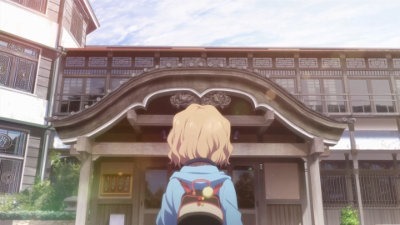
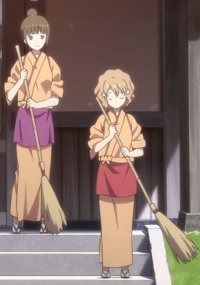 Hanairo is much more than it first seems. It’s very much a character driven series, slowly building up relationships, but also showing real growth and progress. A lot happens. But it’s not a story about world domination or star-crossed lovers. It’s far more real and human, keeping a tight cap on many of the usual cartoony hallmarks of anime. No rainbow palette of hair colors, no overt fanservice, no sweat drops or pratfalls, giant band-aids or hammerspace. Instead we get a realism that is astonishing in its near-flawless execution, and this design decision permeates everything about the show. It’s not that you won’t still see big expressive eyes or guys scratching the back of their head and other hallmarks of anime, but you’ll find the few that are there are subdued.
Hanairo is much more than it first seems. It’s very much a character driven series, slowly building up relationships, but also showing real growth and progress. A lot happens. But it’s not a story about world domination or star-crossed lovers. It’s far more real and human, keeping a tight cap on many of the usual cartoony hallmarks of anime. No rainbow palette of hair colors, no overt fanservice, no sweat drops or pratfalls, giant band-aids or hammerspace. Instead we get a realism that is astonishing in its near-flawless execution, and this design decision permeates everything about the show. It’s not that you won’t still see big expressive eyes or guys scratching the back of their head and other hallmarks of anime, but you’ll find the few that are there are subdued.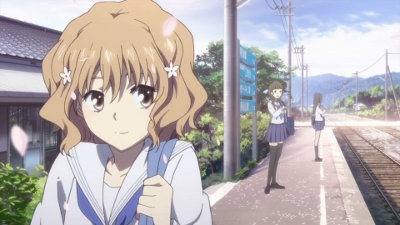

 Hey, internet. It’s time we had a chat. It’s about ponies. No, no, this isn’t some birds-and-the-bees talk where I show you that
Hey, internet. It’s time we had a chat. It’s about ponies. No, no, this isn’t some birds-and-the-bees talk where I show you that 
 Once in a while, an anime series will get popular. Like, really popular. Often it is one of those never-ending serials like Naruto or Bleach, following in the footsteps of early sensations like Dragon Ball.
Once in a while, an anime series will get popular. Like, really popular. Often it is one of those never-ending serials like Naruto or Bleach, following in the footsteps of early sensations like Dragon Ball.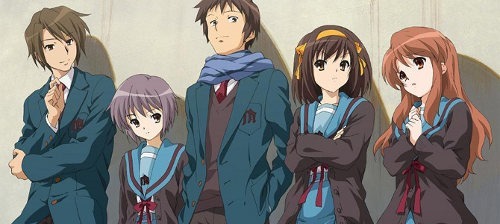
 Back in 2006, I remember sitting down to watch it with some college roommates, knowing little about what I was getting into, and us being in stitches with the first episode (which was actually a filler episode with the whole cast already introduced, none of whom we had any idea who were). This was the famous parody video the characters produce for their school culture festival, a sort of terrible b-movie mash-up of all sorts of anime genres from magical girl to fighting and so on. It managed to do a really good job of both parodying the various genres (with lots of subtle nods and in-jokes) and yet also capture the really shitty student video aspects: characters awkwardly standing/swaying, terrible lines and acting, unfortunate background things like cars driving by as they are filming, amateurish MIDI soundtrack, etc., all on top of a plot that leaps around with no sense of connection.
Back in 2006, I remember sitting down to watch it with some college roommates, knowing little about what I was getting into, and us being in stitches with the first episode (which was actually a filler episode with the whole cast already introduced, none of whom we had any idea who were). This was the famous parody video the characters produce for their school culture festival, a sort of terrible b-movie mash-up of all sorts of anime genres from magical girl to fighting and so on. It managed to do a really good job of both parodying the various genres (with lots of subtle nods and in-jokes) and yet also capture the really shitty student video aspects: characters awkwardly standing/swaying, terrible lines and acting, unfortunate background things like cars driving by as they are filming, amateurish MIDI soundtrack, etc., all on top of a plot that leaps around with no sense of connection.
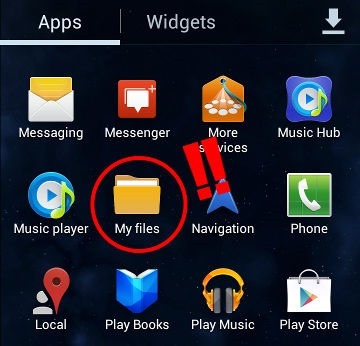
 Is this what we would get if Christopher Nolan attempted a magical girl anime? It is heavily influenced by its pedigree and yet it stops to ask itself constantly “How would this actually work?” It manages to make dark and gritty a genre well known for its colorful sparkles and obnoxiously sweet exterior. Although you wouldn't know it by looking at it.
Is this what we would get if Christopher Nolan attempted a magical girl anime? It is heavily influenced by its pedigree and yet it stops to ask itself constantly “How would this actually work?” It manages to make dark and gritty a genre well known for its colorful sparkles and obnoxiously sweet exterior. Although you wouldn't know it by looking at it.
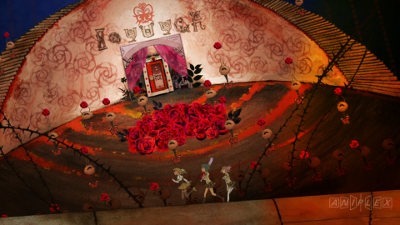
 Never has there been a series that set out to be as pointless and pandering as Lucky Star. It has the slice-of-life comedy of four school age girls approach like Azumanga Daioh and
Never has there been a series that set out to be as pointless and pandering as Lucky Star. It has the slice-of-life comedy of four school age girls approach like Azumanga Daioh and 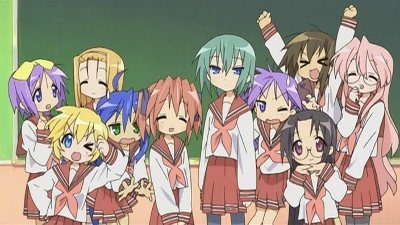
 Its episodic and incredibly meandering approach (why do they even bother titling the episodes?) means it is, at least for me, difficult to marathon watch and is best consumed in small 1-3 episode bunches. But it does mean you can pretty much re-watch them in any order you want since the occasional new character introductions (which you won’t need if you are re-watching) is all that you might miss.
Its episodic and incredibly meandering approach (why do they even bother titling the episodes?) means it is, at least for me, difficult to marathon watch and is best consumed in small 1-3 episode bunches. But it does mean you can pretty much re-watch them in any order you want since the occasional new character introductions (which you won’t need if you are re-watching) is all that you might miss. 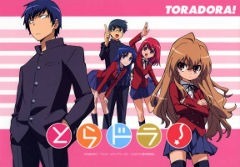 The tiger and dragon stand together as equals. Thus does this too-often generic feeling rom-com begin. While funny and sweet and dramatic at times it feels held back by a lot of typically dumb decisions and watered-down commercial appeal. Even so, there is still a lot to like. A fun diversion, if a bit forgettable in the end.
The tiger and dragon stand together as equals. Thus does this too-often generic feeling rom-com begin. While funny and sweet and dramatic at times it feels held back by a lot of typically dumb decisions and watered-down commercial appeal. Even so, there is still a lot to like. A fun diversion, if a bit forgettable in the end.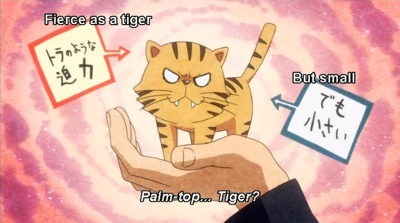
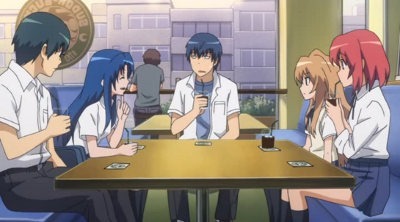
 Despite its predictableness and unoriginality (especially in a lot of the supporting cast), there is still a lot to like here. When it’s good, it tends to be pretty damn good, but it too often gets wobbly and can’t maintain its perch. Often it feels like it is trying too hard to cover all of the bases and be marketable, and it is usually those clichés that frustrate the most. Additionally, I felt that for the majority of the show, the two leads felt way too much like really good siblings. I certainly would have liked to have seen more romantic gestures or hints earlier on, but even with the semi-rushed-romance near the end there is plenty of really good development of trust and intimacy (albeit in a more family kind of way).
Despite its predictableness and unoriginality (especially in a lot of the supporting cast), there is still a lot to like here. When it’s good, it tends to be pretty damn good, but it too often gets wobbly and can’t maintain its perch. Often it feels like it is trying too hard to cover all of the bases and be marketable, and it is usually those clichés that frustrate the most. Additionally, I felt that for the majority of the show, the two leads felt way too much like really good siblings. I certainly would have liked to have seen more romantic gestures or hints earlier on, but even with the semi-rushed-romance near the end there is plenty of really good development of trust and intimacy (albeit in a more family kind of way).
 It’s Glee meets Japanese animation, or perhaps who put K-On! in my Hanasaku Iroha? Three girls and two guys, for various reasons, come together to form a choir club and along the way learn a lot about life, dreams, aspirations, but most of all music and friendship. Yes, it is that kind of show.
It’s Glee meets Japanese animation, or perhaps who put K-On! in my Hanasaku Iroha? Three girls and two guys, for various reasons, come together to form a choir club and along the way learn a lot about life, dreams, aspirations, but most of all music and friendship. Yes, it is that kind of show.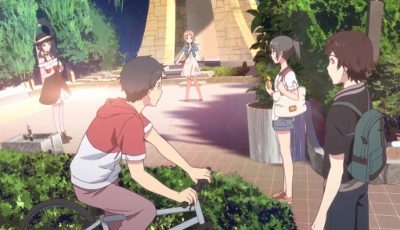
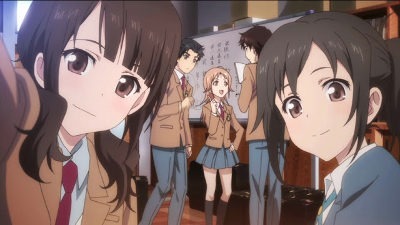
 Papa no Iukoto wo Kikinasai! (or, roughly, Listen To What Your Father Says!) is surprisingly decent given that on first look it seems to be yet another onerous fanservice-heavy dinky harem show. Which, it still is, mind you. It wants to be a meaningful story about family, too, and it does stick to its guns to tell that story. But it undermines itself with the gratuitous boobs, panties, and sexual fetishizing. Worse, the sisters are all cringingly underage (14 and 10). Thankfully the male lead is overwhelmingly kind and non-lecherous. The story it does tell is actually pretty good, but it can’t make up its mind what it wants to be, and in so doing kinda falls short on both.
Papa no Iukoto wo Kikinasai! (or, roughly, Listen To What Your Father Says!) is surprisingly decent given that on first look it seems to be yet another onerous fanservice-heavy dinky harem show. Which, it still is, mind you. It wants to be a meaningful story about family, too, and it does stick to its guns to tell that story. But it undermines itself with the gratuitous boobs, panties, and sexual fetishizing. Worse, the sisters are all cringingly underage (14 and 10). Thankfully the male lead is overwhelmingly kind and non-lecherous. The story it does tell is actually pretty good, but it can’t make up its mind what it wants to be, and in so doing kinda falls short on both. Chuu-Bra!! is a bizarre hybrid of cheesecake and candid discussion. In a nutshell, main character girl is basically an underwear nerd: she loves learning about different kinds of panties/bras and seeing the new designs. Her grandmother was a professional designer and her step-brother has followed that path too. Of course, it’s a very odd hobby to have so get ready for lots of hijinks as everyone misunderstands why she wears such brazen styles (she’s testing her brother’s designs out) and keeps looking at other girls and wanting to critique them.
Chuu-Bra!! is a bizarre hybrid of cheesecake and candid discussion. In a nutshell, main character girl is basically an underwear nerd: she loves learning about different kinds of panties/bras and seeing the new designs. Her grandmother was a professional designer and her step-brother has followed that path too. Of course, it’s a very odd hobby to have so get ready for lots of hijinks as everyone misunderstands why she wears such brazen styles (she’s testing her brother’s designs out) and keeps looking at other girls and wanting to critique them. Recorder and Randsell is easy to digest given that each episode is a mere three minutes. This, coupled with its incredibly dumb plot/premise, means it will probably be a not-so-satisfying hour and a half or so should you decide to watch it. Basically, the two main characters are siblings. The girl is a high-schooler who looks like a ten year-old and her younger brother is a fifth-grader who looks like he’s in his twenties. And that is the entire joke, punctuated too often with pedophile/predator punch lines to end the episode.
Recorder and Randsell is easy to digest given that each episode is a mere three minutes. This, coupled with its incredibly dumb plot/premise, means it will probably be a not-so-satisfying hour and a half or so should you decide to watch it. Basically, the two main characters are siblings. The girl is a high-schooler who looks like a ten year-old and her younger brother is a fifth-grader who looks like he’s in his twenties. And that is the entire joke, punctuated too often with pedophile/predator punch lines to end the episode. Within the first few minutes I knew this would be something good. You ever notice that? When a show strides in and gives you that wink and he’s just so… confident and sexy… and… uh, we’re talking about a twelve episode anime series, right? Yes. Well. If it were anthropomorphized it would be a strapping young man with poise and purpose and your knees would buckle, man. Friggin’ buckle.
Within the first few minutes I knew this would be something good. You ever notice that? When a show strides in and gives you that wink and he’s just so… confident and sexy… and… uh, we’re talking about a twelve episode anime series, right? Yes. Well. If it were anthropomorphized it would be a strapping young man with poise and purpose and your knees would buckle, man. Friggin’ buckle.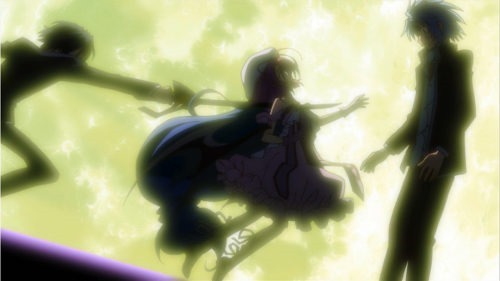
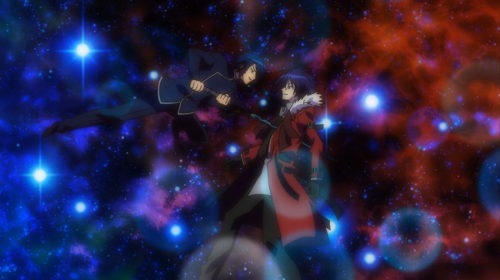
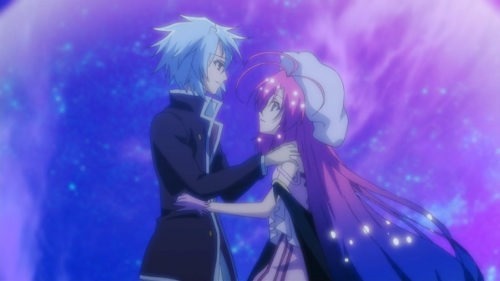
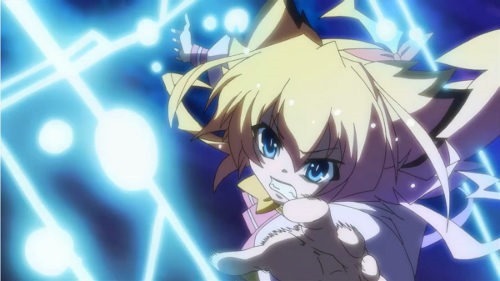
 On an impulse, guy tastes the new girl’s drool on her desk after she slept through class. Several days later he develops flu-like symptoms that won’t go away only to find, as said girl will later tell him, that he is having withdrawal symptoms. She gives him some of her spit and he’s cured. Thus our story of two unlikely love-birds begins.
On an impulse, guy tastes the new girl’s drool on her desk after she slept through class. Several days later he develops flu-like symptoms that won’t go away only to find, as said girl will later tell him, that he is having withdrawal symptoms. She gives him some of her spit and he’s cured. Thus our story of two unlikely love-birds begins.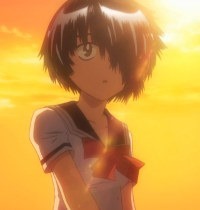 Okay, let me back up a bit. You see, she’s a new transfer student and hasn’t made friends and he feels kinda bad for her. Granted it is mostly self-ostracizing since she is quite anti-social, more than a little strange, and sleeps through lunch/study-hall, etc., so she never really bonds with anyone as a result. But he sits next to her and can’t let it go. One afternoon he comes back to class to retrieve his bag and finds her still asleep at her desk, long after class has ended. He wakes her to tell her school is over and to go home and she does. After she leaves, he sees the large pool of drool on her desk from when she was sleeping. Well, you know what happens after that.
Okay, let me back up a bit. You see, she’s a new transfer student and hasn’t made friends and he feels kinda bad for her. Granted it is mostly self-ostracizing since she is quite anti-social, more than a little strange, and sleeps through lunch/study-hall, etc., so she never really bonds with anyone as a result. But he sits next to her and can’t let it go. One afternoon he comes back to class to retrieve his bag and finds her still asleep at her desk, long after class has ended. He wakes her to tell her school is over and to go home and she does. After she leaves, he sees the large pool of drool on her desk from when she was sleeping. Well, you know what happens after that.